Maytag W10092796B, W10092797B, MVWC400VW User Manual
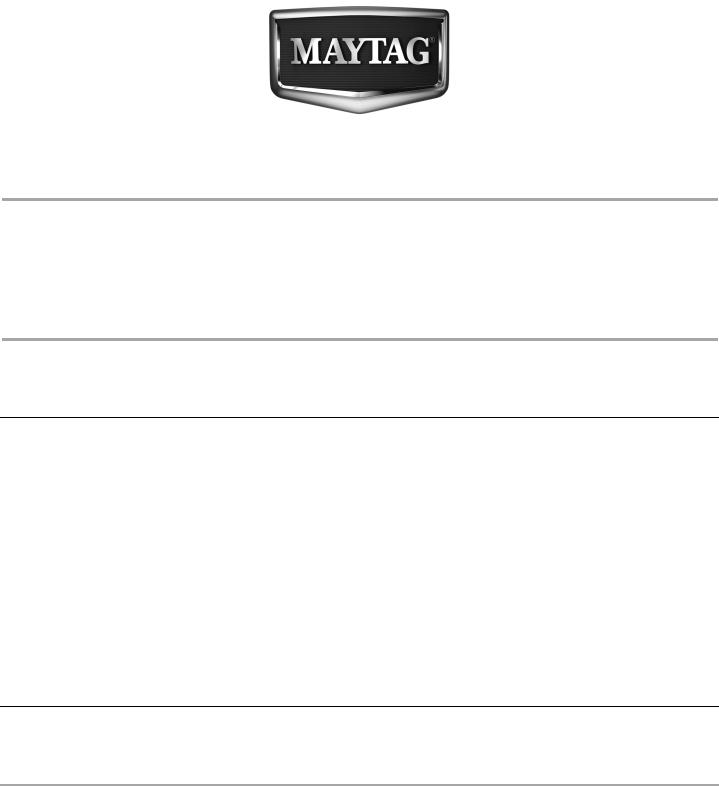
WASHER USER INSTRUCTIONS
INSTRUCTIONS D’UTILISATION DE LA LAVEUSE
Table of Contents / Table des matières
ASSISTANCE OR SERVICE |
.........................................................1 |
WASHER SAFETY....................................................................... |
2 |
WASHER USE............................................................................. |
3 |
WASHER CARE .......................................................................... |
4 |
TROUBLESHOOTING ............................................................... |
5 |
WARRANTY............................................................................... |
8 |
ASSISTANCE OU SERVICE........................................................ |
9 |
SÉCURITÉ DE LA LAVEUSE .................................................... |
10 |
UTILISATION DE LA LAVEUSE............................................... |
11 |
ENTRETIEN DE LA LAVEUSE................................................... |
12 |
DÉPANNAGE .......................................................................... |
13 |
GARANTIE............................................................................... |
16 |
Para obtener acceso al manual de uso y cuidado en español, o para obtener información adicional acerca de su producto, visite: www.maytag.com.
Tenga listo su número de modelo completo. Podrá encontrar el número de modelo y de serie en la etiqueta ubicada debajo de la tapa de la lavadora.
Assistance or Service
If you need assistance or service, first see the “Troubleshooting” section. Additional help is available by calling our Maytag Services, LLC, at 1-800-688-9900 from anywhere in the U.S.A., visiting our website at www.maytag.com or write:
Maytag Services, LLC
Attn: CAIR® Center
P.O. Box 2370
Cleveland, TN 37320-2370
In Canada, for assistance, installation and service, call
1-800-807-6777, visit our website at www.maytag.ca or write:
Whirlpool Canada LP
Customer Interaction Centre
1901 Minnesota Court
Mississauga, Ontario L5N 3A7
Please include a daytime phone number in your correspondence.
Keep this book and your sales slip together for future reference. You must provide proof of purchase or installation date for inwarranty service.
Write down the following information about your appliance to help you obtain assistance or service if you ever need it. You will need to know your complete model number and serial number. You can find this information on the model and serial number label, located under the washer lid.
Dealer name ____________________________________________________
Serial number ___________________________________________________
Address _________________________________________________________
Phone number ___________________________________________________
Model number ___________________________________________________
Purchase date ___________________________________________________
Accessories
Enhance your washer with these premium accessories.
For more high-quality items or to order, call 1-800-901-2042, or visit us at www.maytag.com/accessories.
In Canada, call 1-800-807-6777 or visit us at www.whirlpoolparts.ca.
Part Number |
Accessory |
Part Number |
Accessory |
8212656RP |
10 ft (3.0 m) Inlet hose, Black EPDM (2 pack) |
8212641RP |
5 ft (1.5 m) Inlet hose, Black |
|
|
|
EPDM (2 pack) |
|
|
|
|
8212638RP |
6 ft (1.8 m) Nylon braided inlet hose, space-saving |
8212546RP |
4 ft (1.2 m) Inlet hose, Black |
|
90° elbow, hypro-blue steel couplings. (2-pack) |
|
EPDM (2 pack) |
|
|
|
|
8212487RP |
5 ft (1.5 m) Nylon braided inlet hose. (2-pack) |
8212526 |
Washer drip tray, fits under all |
|
|
|
|
8212637RP |
6 ft (1.8 m) Inlet hose, Black EPDM, space-saving |
31682 |
All purpose appliance cleaner |
|
90° elbow, hypro-blue steel couplings. (2-pack) |
|
|
W10092796B
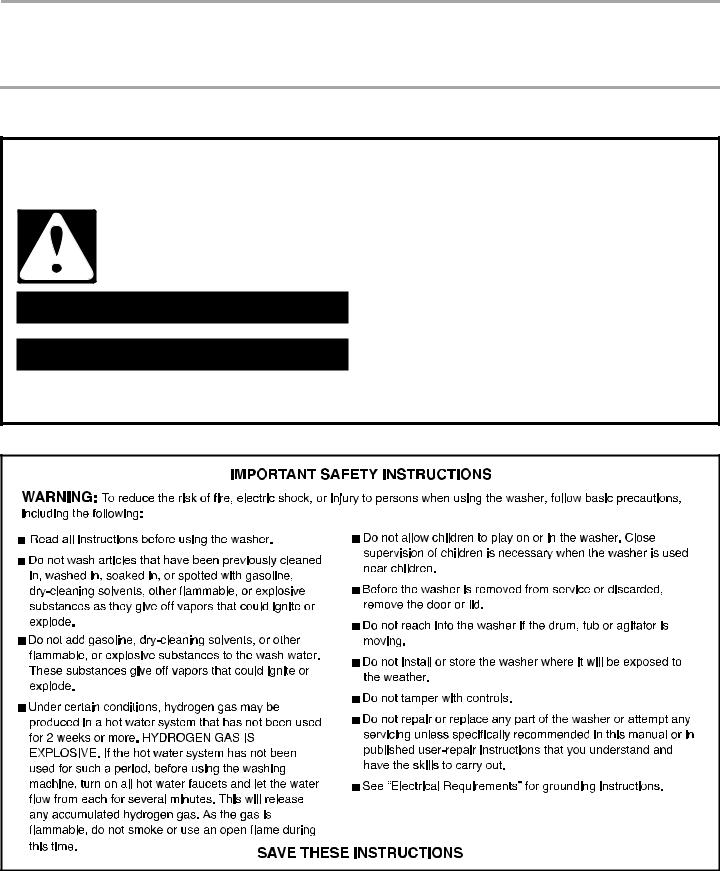
Part Number |
Accessory |
Part Number |
Accessory |
|
|
|
|
8212545RP |
5 ft (1.5 m) Inlet hose, Red and Blue EPDM. |
1903WH |
Laundry supply storage cart |
|
(2-pack) |
|
|
|
|
|
|
This washer does not include inlet water hoses.
WASHER SAFETY
Your safety and the safety of others are very important.
We have provided many important safety messages in this manual and on your appliance. Always read and obey all safety messages.
This is the safety alert symbol.
This symbol alerts you to potential hazards that can kill or hurt you and others.
All safety messages will follow the safety alert symbol and either the word “DANGER” or “WARNING.” These words mean:
 DANGER
DANGER
 WARNING
WARNING
You can be killed or seriously injured if you don't immediately follow instructions.
You can be killed or seriously injured if you don't follow instructions.
All safety messages will tell you what the potential hazard is, tell you how to reduce the chance of injury, and tell you what can happen if the instructions are not followed.
2
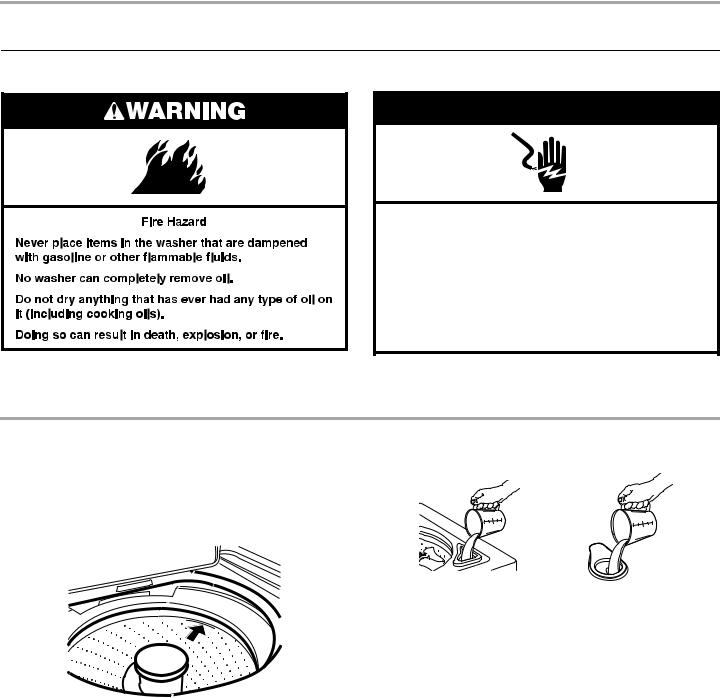
WASHER USE
Starting Your Washer
 WARNING
WARNING
WARNING: To reduce the risk of fire, electric shock, or injury to persons, read the IMPORTANT SAFETY INSTRUCTIONS before operating this appliance.
Electrical Shock Hazard
Plug into a grounded 3 prong outlet.
Do not remove ground prong.
Do not use an adapter.
Do not use an extension cord.
Failure to follow these instructions can result in death, fire, or electrical shock.
1.Measure detergent and pour it into the washer. If desired, add powdered or liquid color safe bleach.
2.Drop a sorted load of clothes loosely into your washer.
■Load evenly to maintain washer balance. Mix large and small items. Items should move easily through the wash water.
■Load only to the top of the basket as shown. Overloading can cause poor cleaning.
3.(OPTIONAL) Add liquid chlorine bleach.
NOTE: Follow the garment and the chlorine bleach manufacturers’ directions for proper use. Undiluted bleach will damage any fabric it touches. The damage appears as rips, holes, tears, or color loss and may not show up until several washings later. To avoid spilling, use a cup with a pouring spout. Do not let bleach splash, drip, or run down into the washer basket. Always measure liquid chlorine bleach. Do not guess. Do not use more than the manufacturer’s recommended amount for a full load. Use less with a smaller load size.
Styles 1 and 2: With liquid chlorine bleach dispenser (on some models)
■Use only liquid chlorine bleach in this dispenser. Do not use this dispenser to add powdered chlorine or color-safe bleach to your wash load. Pour measured liquid chlorine bleach into the liquid chlorine bleach dispenser. Bleach is immediately fed into the washer and is diluted automatically during the wash part of the cycle.
■Dispensers on Timed Bleach models automatically dispense bleach at the proper time in the cycle for optimal performance, ensuring the cleanest and brightest loads.
|
H |
Style 1 |
Style 2 |
Liquid chlorine |
Dispenser for |
bleach dispenser |
Timed Bleach models |
(on some models) |
|
Style 3: Without liquid chlorine bleach dispenser (on some models)
■Let the washer fill and begin agitating the load.
■Add bleach 5 minutes into the wash cycle for best cleaning and so that bleach can be removed in the rinse cycle. Pour bleach around the agitator, not directly onto the load to avoid damaging clothing or other items in the load.
4.(OPTIONAL) Add liquid fabric softener.
NOTE: Do not spill or drip any fabric softener onto the clothes. Undiluted fabric softener can stain fabrics. Always dilute fabric softener with warm water. Using too much fabric softener can make some items (diapers and towels) nonabsorbent. If this happens, do not use it in every load, or use less of it in each load.
3
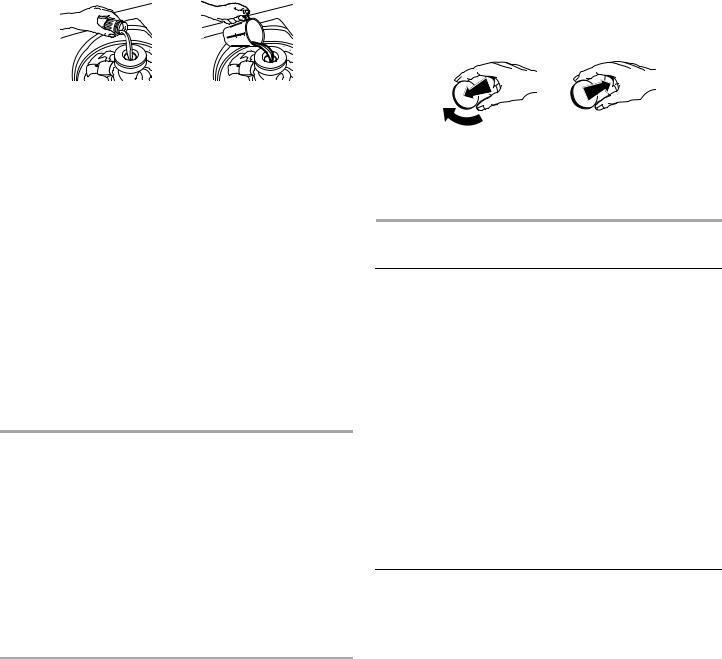
Style 1: With liquid fabric softener dispenser (on some models)
■Use only liquid fabric softener in this dispenser. Pour measured liquid fabric softener into the dispenser. Softener is added automatically during the rinse portion of the cycle. Dilute liquid fabric softener by filling the dispenser with warm water until liquid reaches the underside of the rim. See max fill line arrows.
Style 2: Without liquid fabric softener dispenser (on some models)
■In the final rinse only, add fabric softener that has been diluted with ½ to 1 cup (125 to 250 mL) warm water.
5.Close the washer lid. Washer will not agitate or spin with the lid open.
6.Turn the LOAD SIZE or WATER LEVEL selector to the correct setting for your wash load and the type of fabric being washed.
■You may change the load size or water level selection after the washer has started filling by turning the selector to a different setting.
■On models with a variable Load Size or Water Level control, you should turn the knob to RESET, then to desired setting.
7.Select a Wash Temperature based on the type of fabric and soil being washed. Use the warmest wash water safe for the fabric. Follow garment label instructions.
The Automatic Temperature Control (ATC) (on some models) electronically senses and maintains a uniform water temperature by regulating incoming hot and cold water.
■Even in Cool wash, some warm water is let into the washer to maintain a minimum temperature of approximately 70ºF (21ºC).
Temperature Guide
Wash Temp |
Suggested Fabrics |
|
|
Hot |
Whites and pastels |
|
Durable garments |
|
Heavy soils |
|
|
Warm |
Bright colors |
|
Moderate to light soils |
|
|
Cool |
Colors that bleed or fade |
|
Light soils |
|
|
Cold |
Dark colors that bleed or fade |
|
Light soils |
NOTE: In wash water temperatures colder than 60°F (15.6°C), detergents do not dissolve well. Soils can be difficult to remove. Some fabrics can retain wear wrinkles and have increased pilling (the formation of small lint-like balls on the surface of garments).
8.You can customize your wash by adding rinse Options to your cycle selections. This knob has settings for:
■Extra Rinse - Selecting this option provides a second rinse. An Extra Rinse can be added to any wash cycle.
■Cycle Signal - A tone will sound at the end of the cycle. The sound level cannot be adjusted.
■Extra Rinse & Cycle Signal - This option combines both a Extra Rinse and a Cycle Signal at the end of the wash cycle.
9.The Sensi-Care™ System (on some models) is an integrated set of controls which work together to provide optimal wash temperatures, agitation times, and agitation/spin speeds based on the Fabric Select setting. The controls provide higher wash temperatures for more aggressive, heavy-duty cycles and slightly lower temperatures on cycles for delicate and hand wash items, to provide better fabric care. The timer knob allows you to decrease agitation time for light soils and increase agitation time for heavy soils.
10.Push in the Timer knob and turn it clockwise to the wash cycle you want. Reduce the wash time when using a small water level setting. Pull out the Timer knob to start the washer.
To stop or restart your washer:
■To stop the washer at any time, push in the Timer knob.
■To restart the washer, close the lid (if open) and pull out the Timer knob.
WASHER CARE
Cleaning Your Washer
Use a soft, damp cloth or sponge to wipe up any spills such as detergent or bleach from the outside of your washer.
Clean your washer interior by mixing 1 cup (250 mL) of chlorine bleach and enough detergent to equal twice the manufacturer’s recommended amount for a normal wash load. Pour this mixture into your washer and run it through a complete cycle using hot water. Repeat this process if necessary.
Remove any hard water deposits using only cleaners labeled as washer safe.
Cleaning the liquid fabric softener dispenser (on some models):
1.Remove dispenser by grasping top with both hands and squeezing, while pushing upward with thumbs.
2.Rinse dispenser under warm water, then replace it.
NOTE: Some models are equipped with a liquid fabric softener dispenser. To avoid damage to the washer or clothing, do not wash clothes with the liquid fabric softener dispenser removed or add detergent or bleach to this dispenser; it is for liquid fabric softener only.
Water Inlet Hoses
This washer does not include water inlet hoses. A list of hoses available for separate purchase from Whirlpool Corporation is provided on the first page of this user instructions.
Replace water inlet hoses after 5 years of use to reduce the risk of hose failure. Periodically inspect and replace water inlet hoses if bulges, kinks, cuts, wear, or leaks are found.
When replacing your water inlet hoses, mark the date of replacement on the label with a permanent marker.
4
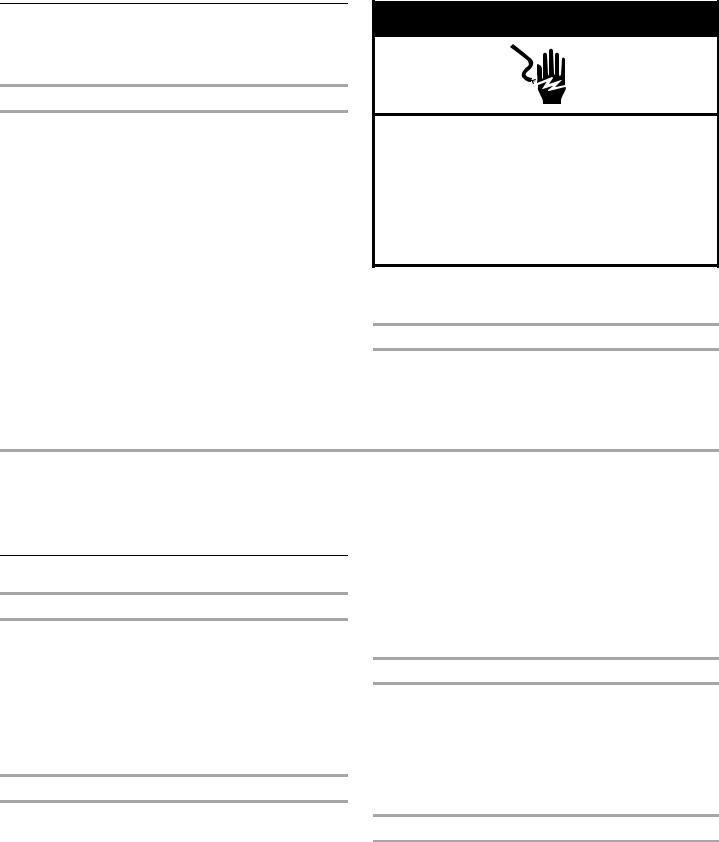
Moving and Storage
Because some water may stay in the hoses, freezing can damage your washer. If storing or moving your washer during freezing weather, winterize it.
Winterizing your washer
1.Shut off both water faucets. Disconnect and drain water inlet hoses. Pour 1 qt (1 L) of R.V.-type antifreeze into the basket.
2.Run washer on a drain and spin setting for about 30 seconds to mix the antifreeze and remaining water.
3.Unplug washer or disconnect power.
To use washer again
1.Flush water pipes and hoses. Reconnect water inlet hoses. Turn on both water faucets.
 WARNING
WARNING
Electrical Shock Hazard
Plug into a grounded 3 prong outlet.
Do not remove ground prong.
Do not use an adapter.
Do not use an extension cord.
Failure to follow these instructions can result in death, fire, or electrical shock.
2.Plug in washer or reconnect power.
3.Run the washer through a complete cycle with 1 cup (250 mL) of detergent to clean out antifreeze.
Storage, non-use, or vacation care
Operate your washer only when you are at home. If you will be on vacation or not using your washer for an extended period of time, you should:
1.Unplug washer or disconnect power.
2.Turn off the water supply to the washer. This helps avoid flooding (due to a water pressure surge) while you are away.
TROUBLESHOOTING
First try the solutions suggested here or visit our website and reference FAQs (Frequently Asked Questions) to possibly avoid the cost of a service call
In U.S.A. www.maytag.com/help In Canada www.maytag.ca
Washer and Components
Noisy
■Is water deflecting off the tub ring or the load? Center the tub before starting the washer. The wash load should be balanced and not overloaded. The fill or spray rinses can deflect off the load. The washer must be level. The front feet should be properly installed and the nuts tightened. Reset the rear leveling legs (if needed). See “Level the Washer.”
■Is the load balanced and the washer level? The wash load should be balanced and not overloaded. The washer must be level. The front feet should be properly installed and the nuts tightened. Reset the rear leveling legs (if needed). See “Starting Your Washer.”
■Check household plumbing for leaks.
Basket crooked
■Did you completely remove the yellow shipping strap with shipping pins? See “Remove Shipping Materials.”
■Are the gears engaging after the drain and before spin, or is the upper part of agitator clicking during wash? These are normal washer noises.
Leaking
■Check the following:
Are the fill hoses tight?
Are the fill hose washers properly seated?
■Is the sink or drain clogged? Sink and standpipe must be able to handle 17 gal. (64 L) of water per minute.
■Was the washer basket pulled forward during loading? Push the basket to the center before starting wash.
■Is the load balanced and the washer level? The wash load should be balanced and not overloaded. The washer must be level. The front feet should be properly installed and the nuts tightened. Reset the rear leveling legs (if needed). See “Level the Washer.”
■The washer basket moves while washing. This is normal.
Agitator operation
■The top of the agitator is loose, or moves in only one direction.
This is normal.
5
